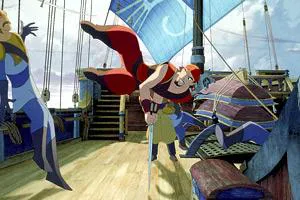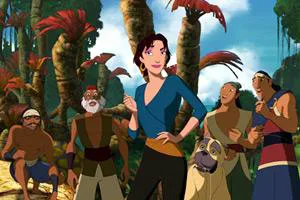A Hollywood Take on Ancient Tales: “Sinbad: Legend of the Seven Seas”
While the summer Hollywood cartoon “Sinbad: Legend of the Seven Seas” borrows the name and profession of its protagonist from “One Thousand and One Nights,” the connection ends there. But does this mean it’s a bad or harmful film? Not at all. Despite being geared towards a younger audience, it’s most enjoyable for those familiar with “One Thousand and One Nights” and perhaps even Greek mythology. Assuming viewers have some exposure to Hollywood tropes, “Sinbad: Legend of the Seven Seas” emerges as a refreshing and amusing parody of how Hollywood perceives the ancient world.

The film’s portrayal of the Old World is distinctly American, reminiscent of the humor in “Dumb and Dumber,” where Abraham Lincoln is comically portrayed as a communist who defeated Godzilla with penicillin. Sinbad is depicted as a small-time ancient Arab gangster, engaging in petty theft but quick to flee at the sight of a larger threat. Confronted with a “drug lord,” he immediately kowtows. In this case, the “drug lord” is Eris, the ancient Greek goddess of chaos, who desires the same trinket as Sinbad: the Book of Peace from Syracuse. He rashly promises to retrieve it for her. However, Syracuse, analogous to the White House, is not to be trifled with, leaving the petty gangster with little chance of success. Yet, Sinbad has connections within the “Oval Office” and attempts to manipulate events to his advantage, hoping to escape to a hammock on the Fiji Islands. He nearly succeeds, but his childhood friend, the son of the Syracusan despot, has a beautiful fiancée. Naturally, Sinbad can’t resist the temptation to seduce her. Thus, Sinbad and Marina embark on an unexpected journey to the edge of the world, their next stop being Tartarus, where Eris has hidden the stolen book.

The Hilarious Mashup of Mythologies
The film’s charm lies in its audacious blending of Greek, Arab, Roman, and medieval mythologies with elements of B-movie Hollywood. The more blatant the mix, the funnier it becomes, as the parody hits its mark. Imagine a small-time Hollywood producer from Beverly Hills telling a bedtime story about ancient history to a child. It would likely resemble the exaggerated tales of a shady character running a gas station in the outskirts of Moscow.

The Beverly Hills version maintains the same essence, albeit with added security at lavish Syracusan parties, dialogue from the despot’s son like, “Let me introduce you to someone. - To me?”, and Sinbad’s physical resemblance to Russell Crowe’s Gladiator. Crowe was initially intended to voice the character but was replaced by Brad Pitt, though the resemblance and mannerisms remain. This type of adaptation is valuable because it presents ancient history in an engaging way, even if it’s through a comical lens.

The Creative Force Behind the Parody
The credit for this parody goes to the film’s screenwriter, John Logan. A respected figure, Logan’s previous works include “The Last Samurai” (2003), “Gladiator” (2000), and even “RKO 281” (1999), a satirical take on the making of “Citizen Kane.” Logan clearly understands the nuances of Beverly Hills culture and infused that knowledge into Sinbad, the Syracusans, and the Greek gods. The original voice acting by Brad Pitt, Michelle Pfeiffer, Catherine Zeta-Jones, and Joseph Fiennes undoubtedly enhanced the film, although this is often lost in translation due to dubbing.

Visual Style and Animation
In terms of computer-generated special effects, “Sinbad: Legend of the Seven Seas” lags behind the benchmark set by “Shrek.” However, it compensates with a unique visual approach that aligns with its overall theme. Just as the story of the Ancient World is filtered through a Hollywood lens, the world itself is presented through a cinematic perspective. The film employs classic cinematic techniques, such as dramatic angles. Instead of relying on frontal shots with massive crowds, the film favors dynamic perspectives from the crest of a wave, the yardarm of a ship, beneath a stone, or from the executioner’s block. While all computer-generated, these angles create a dynamic and almost interactive experience. The first battle with the octopus, the race with the whale-island-surfer, the giant white bird in the ice, the edge of the world, and the subsequent Tartarus are all visually captivating.

The animation style itself (directed by Tim Johnson and Patrick Gilmore) is deliberately simplistic. Sinbad, his sailors, Marina, Eris, the prince, and even the ship’s bulldog are rendered with minimal detail. However, this minimalist approach aligns with the film’s parodic nature, allowing for maximum impact in specific actions, recognitions, or emotions.
The film is packed with action. While not a masterpiece, it offers an entertaining escape.